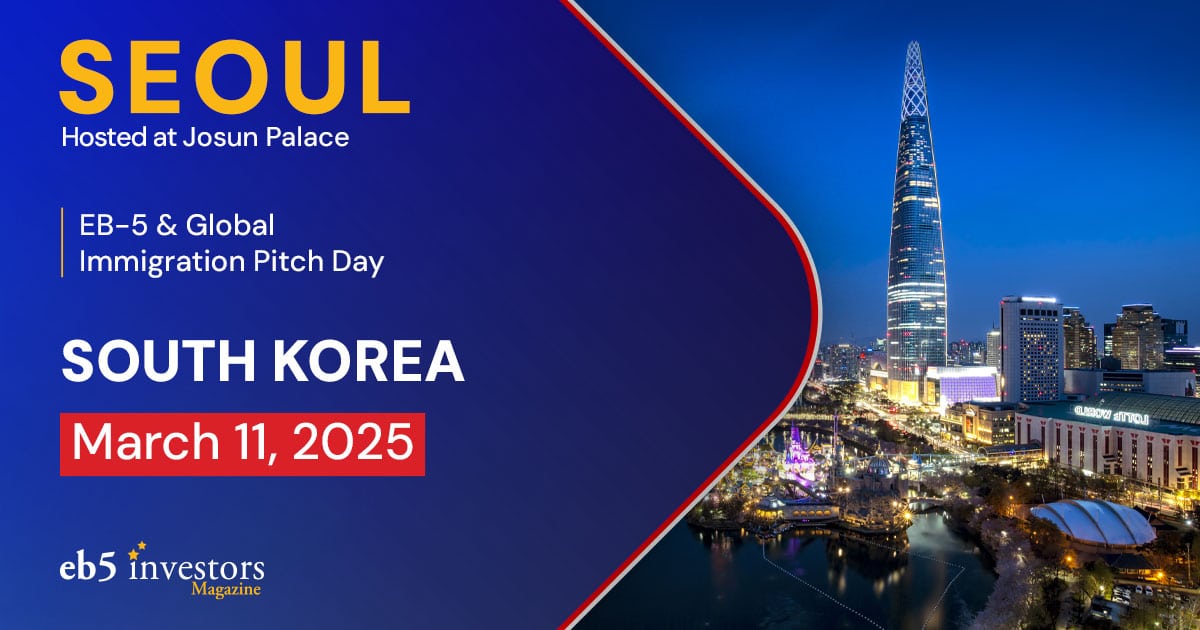
The EB-5 Immigrant Investor Program is an attractive option for wealthy South American investors pursuing the American dream.
In 2023, the U.S. government granted nearly 400 EB-5 visas and adjustment of status in the unreserved and set-asides categories to South American investors, with Brazilian and Venezuelan applicants receiving the majority, according to Department of State data.
While different motivations depend on their nationality or country of residence, U.S. immigration experts affirm that South American investors share common drivers for applying for this U.S. green card, being stability the overarching motivation.
Where do South American investor migrants go?
According to Marcelo Gorenstein, director for Brazil at LCR Capital Partners, the Spanish and Portuguese investment visa programs in Europe and the EB-5 green card are the most popular options for these nations. The history of South Americans relocating to the U.S. is strong due to the geographical and cultural connection between these regions, he said.
“The country continues to be the most desired destination for spending holidays or immigrating through what we call ‘full family transition,’ when the whole family moves to a new country and starts a new life,” he says.
In the case of the European programs, however, those investors don’t necessarily look to live and start a new life. “They look, instead, to having the possibility to easily and quickly immigrate in case of social or economic unrest in their home country,” Gorenstein adds. “The Portugal Golden Visa allows for great flexibility with a minimum requirement of only seven days to stay in the country and maintain the immigrant visa status. The Spanish program offers great advantages for citizens from ex-colonies to acquire citizenship after having permanent residence in the country: they only need to wait for two years to be eligible for citizenship – as opposed to ten years for citizens from non-colony countries.”
Key drivers behind South American EB-5 investors’ interest
Gorenstein explains that, in general, these countries “historically have significant economic and political instability. Those factors can be a strong motivation for citizens to look for a ‘plan B’ country to live in. It is common for their citizens to have dual citizenship, having acquired a European passport through family heritage. When this is not the case, however, many times, they seek such an alternative and apply for investor visa programs to obtain another permanent residence in what is considered a safer country.”
Andres Echevarria, an immigration attorney from Vivanco & Vivanco, adds that periods of political and economic turbulence “can prompt families to expedite their decision to emigrate to the U.S. in search of stability and a more predictable future. This urgency often results from a desire to escape the uncertainties that can affect personal safety, economic security, and overall quality of life in their home countries.”
Safety issues like crime and securing a green card for their children are also strong deciding factors. “Obtaining a green card places their children on equal footing with U.S. citizens when competing for jobs, significantly enhancing their career prospects and educational opportunities,” Echevarria said. “The EB5 visa provides a direct path to permanent residency, ensuring that children can grow up and integrate seamlessly into the American market and society.”
Who is the South American EB-5 investor?
Echeverria adds that different situations in Argentina, Colombia, Brazil, and Venezuela drive many families to seek the stability offered by the U.S. For example, Argentina’s economic volatility and currency fluctuations prompt families to view the EB-5 visa as a strategic move to safeguard their wealth. Similarly, Colombian investors seek safety and the desire to escape the lingering effects of past conflicts and remaining security challenges.
Meanwhile, the immigration attorney adds, other reasons influence Brazilians and Venezuelans interests. “Brazil is simply a huge market with thousands of wealthy families. Venezuelan clients, on the other hand, are often driven by the dire economic and humanitarian crisis in their home country. The severe conditions in Venezuela make the prospect of a new life in the U.S. especially urgent and appealing for these families,” Echeverria states.
Regarding their approach to the EB-5 application, they tend to be more involved in the process than their Asian counterparts when assessing projects and potential investments, says securities attorney and founder of Carrasquillo Law Group in New York, Rogelio Carrasquillo. “These investors tend to also look for projects that are in industries they understand or that they may even be involved in their home countries. This allows them better to evaluate the project and the terms of the investment. It also makes them more demoing regarding their return on investment.
Gorenstein also highlights: “One important trend we have noticed among those who are applying for the U.S. EB-5 investor visa program is that many have been in the U.S. already, with a different, non-immigrant visa (such as H1-B, F-1, L-1, or E-2) and are looking for a solution with less hassle and more permanent status, less dependent on their own business or other parties. The fact that the EB-5 Investor Visa program allows for Concurrent Adjustment of Status since the law was reformed in 2022 makes the program much more interesting for such audience because this means that having a pending EB-5 application may give them the right to work and travel outside the US while waiting for the EB-5 petition to be adjudicated.
What challenges do EB-5 investors coming from South America face?
Providing a sound source of funding is a common challenge every EB-5 investor faces, regardless of nationality. However, for South American applicants, it can become particularly difficult depending on the home country.
Echevarría says sometimes, the informality of their home economies can be an obstacle. “Many South American economies have historically been informal, which complicates the source of funds documentation required for the EB-5 visa. Investors must provide detailed and transparent evidence of the origins of their investment capital. In economies where cash transactions and informal business practices are common, compiling the necessary documentation to meet U.S. immigration standards can be particularly arduous. This requirement often extends the timeline and increases the difficulty of the application process for South American clients.
Regulatory and tax bureaucracy can also pose barriers, depending on the nationality of South Americans, Carrasquillo explains. “For example, as their counterparts in China, countries such as Venezuela have strict currency exchange controls limiting the amount of capital that can be delivered into the United States. Also, there are countries that have imposed monthly limits, special taxes, and other measures to discourage investors from investments outside of their home country.”
Another example is the limit on the amount of U.S. dollars that Argentinean investors can legally purchase monthly and the taxes on foreign currency transactions they must budget, which can be as high as a 30% tax (PAIS tax) on the purchase of foreign currency and a 35% advance tax on income and personal assets for certain transactions.
Hiring financial advisors to help them navigate their home countries’ banking and regulatory policies to comply with the law is as relevant to these investors as hiring advice to navigate EB-5, Carrasquillo cautions. “We have had many Venezuelan investors that, to work around this issue, would commission a report from an accounting or financial firm that can support an investor’s petition.”
Echeverria concludes that these challenges help better understand why decision-making for an EB-5 investment tends to be slower in the South American region. “Cultural factors and a general cautiousness in financial matters contribute to a more deliberate consideration process. Potential investors often take more time to consider their options, conduct due diligence, and consult with family and advisors before committing to the EB5 program. This slower pace can be a disadvantage in a competitive visa program where timely decision-making is often crucial.”
If you are interested in attending our Buenos Aires conference in November, contact us here!
DISCLAIMER: The views expressed in this article are solely the views of the author and do not necessarily represent the views of the publisher, its employees. or its affiliates. The information found on this website is intended to be general information; it is not legal or financial advice. Specific legal or financial advice can only be given by a licensed professional with full knowledge of all the facts and circumstances of your particular situation. You should seek consultation with legal, immigration, and financial experts prior to participating in the EB-5 program Posting a question on this website does not create an attorney-client relationship. All questions you post will be available to the public; do not include confidential information in your question.








